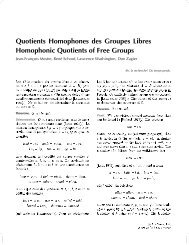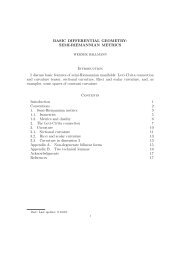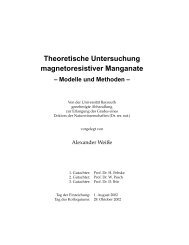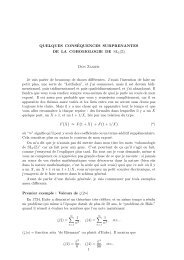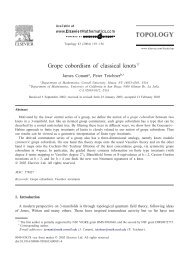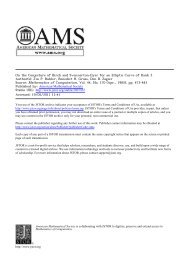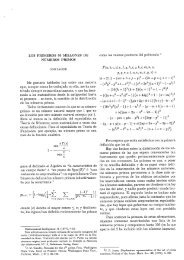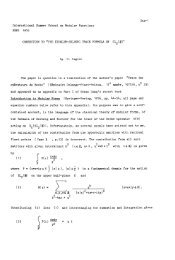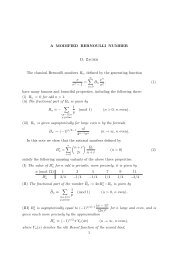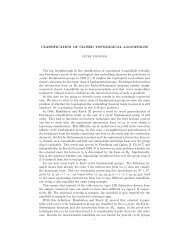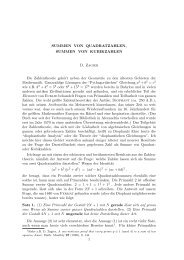40 D. Zagierler product L(f,s) =∏ ( a p 1+p prime p s + a p 2p 2s + ···), <strong>and</strong> the second tells usthat the power series ∑ ∞ν=0 a p ν xν for p prime equals 1/(1 − a p x + p k−1 x 2 ).Combining these two statements gives Hecke’s fundamental Euler productdevelopmentL(f,s) =∏11 − a p p −s + p k−1−2s (44)p primefor the L-series of a normalized Hecke eigenform f ∈ M k (Γ 1 ),asimpleexamplebeing given byL(G k ,s) = ∏ p11 − (p k−1 +1)p −s = ζ(s) ζ(s − k +1).+ pk−1−2s For eigenforms on Γ 0 (N) there is a similar result except that the Euler factorsfor p|N have to be modified suitably.The L-series have another fundamental property, also discovered by Hecke,which is that they can be analytically continued in s <strong>and</strong> then satisfy functionalequations. We again restrict to Γ = Γ 1 <strong>and</strong> also, for convenience, tocusp forms, though not any more just to eigenforms. (The method of proof extendsto non-cusp forms but is messier there since L(f,s) then has poles, <strong>and</strong>since M k is spanned by cusp forms <strong>and</strong> by G k ,whoseL-series is completelyknown, there is no loss in making the latter restriction.) From the estimatea n = O(n k/2 ) proved in §2.4 we know that L(f,s) converges absolutely in thehalf-plane R(s) > 1+k/2. Takes in that half-plane <strong>and</strong> consider the Eulergamma function∫ ∞Γ (s) = t s−1 e −t dt .0Replacing t by λt in this integral gives Γ (s) =λ ∫ s ∞t s−1 e −λt dt or λ −s =0Γ (s) ∫ −1 ∞t s−1 e −λt dt for any λ>0. Applying this to λ =2πn, multiplying0by a n , <strong>and</strong> summing over n, weobtain(2π) −s Γ (s) L(f,s) =∞∑∫ ∞a n t s−1 e −2πnt dt = t s−1 f(it) dt00(R(s) > k )2 +1 ,n=1∫ ∞where the interchange of integration <strong>and</strong> summation is justified by the absoluteconvergence. Now the fact that f(it) is exponentially small for t →∞(because f is a cusp form) <strong>and</strong> for t → 0 (because f(−1/z) =z k f(z) )impliesthat the integral converges absolutely for all s ∈ C <strong>and</strong> hence that thefunctionL ∗ (f,s) := (2π) −s Γ (s) L(f,s) = (2π) −s Γ (s)∞∑n=1a nn s (45)
<strong>Elliptic</strong> <strong>Modular</strong> <strong>Forms</strong> <strong>and</strong> <strong>Their</strong> <strong>Applications</strong> 41extends holomorphically from the half-plane R(s) > 1+k/2 to the entirecomplex plane. The substitution t → 1/t together with the transformationequation f(i/t) =(it) k f(it) of f then gives the functional equationof L ∗ (f,s). Wehaveproved:L ∗ (f,k − s) = (−1) k/2 L ∗ (f,s) (46)Proposition 13. Let f = ∑ ∞n=1 a nq n be a cusp form of weight k on thefull modular group. Then the L-series L(f,s) extends to an entire functionof s <strong>and</strong> satisfies the functional equation (46), whereL ∗ (f,s) is defined byequation (45).It is perhaps worth mentioning that, as Hecke also proved, the converse ofProposition 13 holds as well: if a n (n ≥ 1) are complex numbers of polynomialgrowth <strong>and</strong> the function L ∗ (f,s) defined by (45) continues analytically to thewhole complex plane <strong>and</strong> satisfies the functional equation (46), then f(z) =∑ ∞n=1 a ne 2πinz is a cusp form of weight k on Γ 1 .4.3 <strong>Modular</strong> <strong>Forms</strong> <strong>and</strong> Algebraic Number TheoryIn §3, we used the theta series θ(z) 2 to determine the number of representationsof any integer n as a sum of two squares. More generally, we canstudy the number r(Q, n) of representations of n by a positive definite binaryquadratic Q(x, y) =ax 2 + bxy + cy 2 with integer coefficients by consideringthe weight 1 theta series Θ Q (z) = ∑ x,y∈Z qQ(x,y) = ∑ ∞n=0 r(Q, n)qn .Thistheta series depends only on the class [Q] of Q up to equivalences Q ∼ Q ◦ γwith γ ∈ Γ 1 . We showed in §1.2 that for any D1), then h(D) equals the classnumber of the imaginary quadratic field K = Q( √ D) of discriminant D <strong>and</strong>there is a well-known bijection between the Γ 1 -equivalence classes of binaryquadratic forms of discriminant D <strong>and</strong> the ideal classes of K such that r(Q, n)for any form Q equals w times the number r(A,n) of integral ideals a of Kof norm n belonging to the corresponding ideal class A, wherew is the numberof roots of unity in K (= 6 or 4 if D = −3 or D = −4 <strong>and</strong> 2 otherwise).The L-series L(Θ Q ,s) of Θ Q is therefore w times the “partial zetafunction”ζ K,A (s) = ∑ a∈A N(a)−s . The ideal classes of K form an abeliangroup. If χ is a homomorphism from this group to C ∗ , then the L-seriesL K (s, χ) = ∑ a χ(a)/N (a)s (sum over all integral ideals of K) canbewrittenas ∑ A χ(A) ζ K,A(s) (sum over all ideal classes of K) <strong>and</strong> hence is theL-series of the weight 1 modular form f χ (z) =w −1 ∑ A χ(A)Θ A(z). Ontheother h<strong>and</strong>, from the unique prime decomposition of ideals in K it followsthat L K (s, χ) has an Euler product. Hence f χ is a Hecke eigenform. If χ = χ 0is the trivial character, then L K (s, χ) =ζ K (s), the Dedekind zeta function



